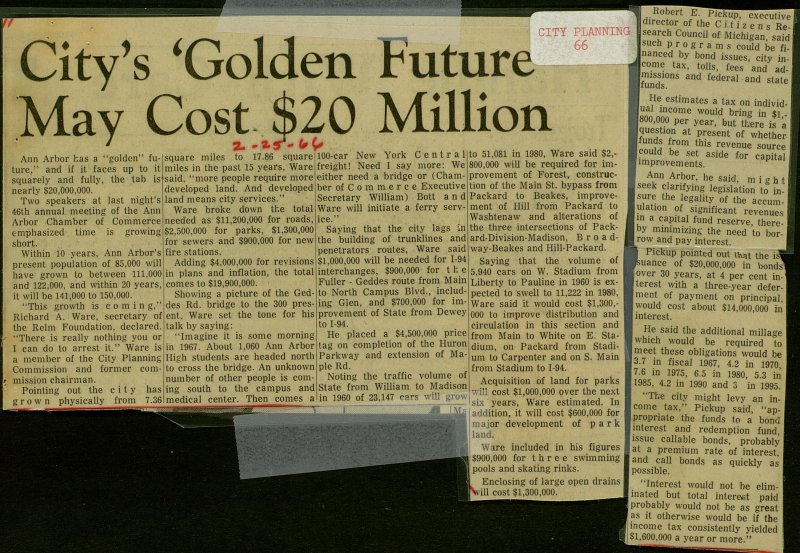City's 'Golden Future May Cost $20 Million

Ann Arbor has a "golden" future, and if it faces up to it squarely and fully, the tab is nearly $20,000,000. Two speakers at last night's 46th annual meeting of the Ann Arbor Chamber of Commerce emphasized time is growing short. Within 10 years, Ann Arbor's present population of 85,000 will have grown to between 111,000 and 122,000, and within 20 years, it willbe 141,000 to 150,000. "This growth is coming," Richard A. Ware, secrctary of the Relm Foundation, declared. "There is really nothing you or I can do to arrest it." Ware is a member of the City Planning Commission and former commission chairman. Pointing out the city has grown physically from 7.36 square miles to 17.86 square miles in the past 15 years, Ware said, "more people require more developed land. And developed land means city services." Ware broke down the total needed as $11,200,000 for roads, $2,500,000 for parks, $1,300,000 for sewers and $900,000 for new fire stations. Adding $4,000,000 for revisions in plans and inflation, the total comes to $19,900,000. Showing a picture of the Geddes Rd. bridge to the 300 present, Ware set the tone for his talk by saying: "Imagine it is some morning in 1967. About 1,060 Ann Arbor High students are headed north to cross the bridge. An unknown number of other people is coming south to the campus and medical center. Then comes a 100-car New York Central freight! Need I say more: We either need a bridge or (Chamber of Commerce Executive Secretary William) Bott and Ware will initiate a ferry service." Saying that the city lags in the 'building of trunklines and penetrators routes, Ware said $1,000,000 will be needed for I-94 interchanges, $900,000 for the Fuller - Geddes route from Main to North Campus Blvd., including Glen, and $700,000 for improvement of State from Dewey to 1-94. He placed a $4,500,000 price tag on completion of the Huron Parkway and extension of Maple Rd. Noting the traffic volume of State from William to Madison in 1960 of 23,147 cars will grow to 51,081 in 1980, Ware said $2,800,000 will be required for improvement of Forest, construction of the Main St. bypass from Packard to Beakes, improvement of Hill from Packard to Washtenaw and alterations of the three intersections of Packard-Division-Madison, Broadway-Beakes and Hill-Packard. Saying that the volume of I 5,940 cars on W. Stadium from Liberty to Pauline in 1960 is expected to swell to 11,222 in 1980, Ware said it would cost $1,300,000 to improve distribution and circulation in this section and from Main to White on E. Stadium, on Packard from Stadium to Carpenter and on S. Main from Stadium to 1-94. Acquisition of land for parks will cost $1,000,000 over the next six years, Ware estimated. In addition, it will cost $600,000 for major development of parkland. Ware included in his figures $900,000 for three swimming pools and skating rinks. Enclosing of large open drains will cost $1,300,000. Robert E. Pickup, executive director of the Citizens Research Council of Michigan, said such programs could be financed by bond issues, city income tax, tolls, fees and admissions and federal and state funds. He estimates a tax individual income would bring in $1,800,000 per year, but there is a question at present of whether funds from this revenue source could be set aside for capital improvements. Ann Arbor, he said, might seek clarifying legislation to ensure the legality of the accumulation of significant revenues in a capital fund reserve, thereby minimizing the need to borrow and pay interest. Pickup pointed out that the issuance of $20,000,000 in bonds over 30 years, at 4 per cent interest with a three-year deferment of payment on principal would cost about $14,000,000 in interest. He said the additional millage which would be required to meet these obligations would be 3.7 in fiscal 1967, 4.2 in 1970, 7.6 in 1975, 6.5 in 1980, 5.3 in 1985, 4.2 in 1990 and 3 in 1995. "The city might levy an income tax," Pickup said, "appropriate the funds to a bond interest and redemption fund, issue callable bonds, probably at a premium rate of interest, and call bonds as quickly as possible. "Interest would not be eliminated but total interest paid probably would not be as great as it otherwise would be if the income tax consistently yielded $1,600,000 a year or more."
Article
Subjects
Traffic
Taxation - Ann Arbor & Washtenaw County
Streets & Roads
Statistics
Reim Foundation
Demographics
Citizens Research Council of Michigan
Ann Arbor City Planning Commission
Ann Arbor - City Planning
Ann Arbor - Budget
Ann Arbor News
Old News
William J. Bott
Robert E. Pickup
Richard A. Ware